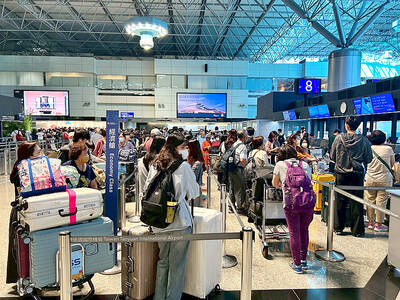Opposition legislators today urged the central government to halt production of 58 wind turbines in Taitung County, citing public opinion polls that predominately oppose the project.
The turbines would be built along Provincial Highways 9 and 11, turning Taiwan’s most beautiful, internationally renowned coastline into a row of large artificial fans, Chinese Nationalist Party (KMT) Legislator Huang Chien-pin (黃建賓) said.
The wind turbines would threaten the local ecosystem, emit low-frequency noise that would affect public health and impact indigenous people’s traditional territories, Huang said.

Photo: Chen Yi-kuan, Taipei Times
According to a poll conducted by Taiwan Real Survey, 50.7 percent of Taitung residents do not support installing wind turbines along the county’s coast and only 24.2 percent support it, he said.
There is also a plan to build 14 wind turbines along a 7km stretch of the coast of Yilan County’s Wuchieh (五結) and Suao (蘇澳) townships, KMT Legislator Wu Tsung-hsien (吳宗憲) said.
This area includes the Lanyang Rivermouth Waterbird Refuge and Wushierjia Wetlands, which have sensitive ecosystems that would be destroyed by the wind turbines’ construction, Wu said.
It would also impact local landscapes and public health, he added.
Independent Legislator May Chin (高金素梅) said that data from Taiwan Power Co (Taipower) has shown that wind power is inefficient.
She questioned why the government would want to destroy Taiwan’s last piece of pristine coastline to build wind turbines, which have already been proven as inefficient energy sources.
KMT Legislator Sra Kacaw said that leaders of the Amis indigenous communities in Taitung’s Changbin Township (長濱) have already signed a joint statement calling on the government and developers to halt production of the turbines.
This shows that local communities already have a clear stance against wind turbine production, which would damage the environment and traditional territories, he said.

Three batches of banana sauce imported from the Philippines were intercepted at the border after they were found to contain the banned industrial dye Orange G, the Food and Drug Administration (FDA) said yesterday. From today through Sept. 2 next year, all seasoning sauces from the Philippines are to be subject to the FDA’s strictest border inspection, meaning 100 percent testing for illegal dyes before entry is allowed, it said in a statement. Orange G is an industrial coloring agent that is not permitted for food use in Taiwan or internationally, said Cheng Wei-chih (鄭維智), head of the FDA’s Northern Center for

The Chinese military has built landing bridge ships designed to expand its amphibious options for a potential assault on Taiwan, but their combat effectiveness is limited due to their high vulnerability, a defense expert said in an analysis published on Monday. Shen Ming-shih (沈明室), a research fellow at the Institute for National Defense and Security Research, said that the deployment of such vessels as part of the Chinese People’s Liberation Army (PLA) Navy’s East Sea Fleet signals a strong focus on Taiwan. However, the ships are highly vulnerable to precision strikes, which means they could be destroyed before they achieve their intended

LOOKING NORTH: The base would enhance the military’s awareness of activities in the Bashi Channel, which China Coast Guard ships have been frequenting, an expert said The Philippine Navy on Thursday last week inaugurated a forward operating base in the country’s northern most province of Batanes, which at 185km from Taiwan would be strategically important in a military conflict in the Taiwan Strait. The Philippine Daily Inquirer quoted Northern Luzon Command Commander Lieutenant General Fernyl Buca as saying that the base in Mahatao would bolster the country’s northern defenses and response capabilities. The base is also a response to the “irregular presence this month of armed” of China Coast Guard vessels frequenting the Bashi Channel in the Luzon Strait just south of Taiwan, the paper reported, citing a

About 4.2 million tourist arrivals were recorded in the first half of this year, a 10 percent increase from the same period last year, the Tourism Administration said yesterday. The growth continues to be consistent, with the fourth quarter of this year expected to be the peak in Taiwan, the agency said, adding that it plans to promote Taiwan overseas via partnerships and major events. From January to June, 9.14 million international departures were recorded from Taiwan, an 11 percent increase from the same period last year, with 3.3 million headed for Japan, 1.52 million for China and 832,962 to South Korea,